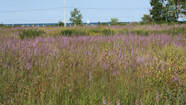Key challenges to the Pike-Root watershed
|
The Pike-Root Watershed covers 410 square miles in Wisconsin and Illinois. Streams and rivers in the watershed drain to Lake Michigan. It includes 113 miles of Lake Michigan shoreline.
Significant Natural Features
 Chiwaukee Prairie in WI. Source: http://www.visitkenosha.com/things-to-do/chiwaukee-prairie Chiwaukee Prairie in WI. Source: http://www.visitkenosha.com/things-to-do/chiwaukee-prairie
The Chiwaukee Illinois Beach Lake Plain was designated a Wetland of International Importance by the US government. It straddles the Wisconsin-Illinois border on the Lake Michigan coast. The Plain includes area within Pleasant Prairie in Wisconsin and Winthrop Harbor, Zion and Waukegan in Illinois. It includes 6 globally rare wetland types. It is home to the piping plover, Blandings turtle, and the eastern prairie fringed orchid, which are on lists of threatened and endangered species.
Image sources: https://en.wikipedia.org/wiki/Blanding%27s_turtle; https://en.wikipedia.org/wiki/Piping_plover; https://www.fws.gov/midwest/endangered/plants/epfo/EPFOsurvey5May2014.html; accessed 1/16/18
Other important plant species found in the watershed include Pale False Foxglove, Fringed Aster, and Prairie White-fringed Orchid.
The watershed is an important stopover habitat for migratory birds. Lake Michigan is the source of drinking water for the majority of the population in these counties. Community water utilities treat and distribute Lake Michigan water. These utilities report no contaminant levels exceeding US EPA quality standards. |
Needed Actions
|
Read More
|
|
Wisconsin DNR Overview
USEPA Watershed Central wiki Watershed Plans Pike and Root River Watersheds Pike River Watershed Plan Root River Watershed Plan Wind Point Watershed Plan Oak Creek Watershed Plan Waukegan River Watershed Plan Kellogg Creek Watershed Plan Dead River Watershed Plan Great Lakes Restoration Initiative |
More information is available on the full fact sheet. Click below to read, download or print.
|
|
League of Women Voters Lake Michigan Region
980 N. Michigan Avenue Suite 1400 PMB 239 Chicago IL 60611 [email protected] © Copyright League of Women Voters Lake Michigan Region. All rights reserved. |
Sign Up for Email Updates
For Email Newsletters you can trust. |
